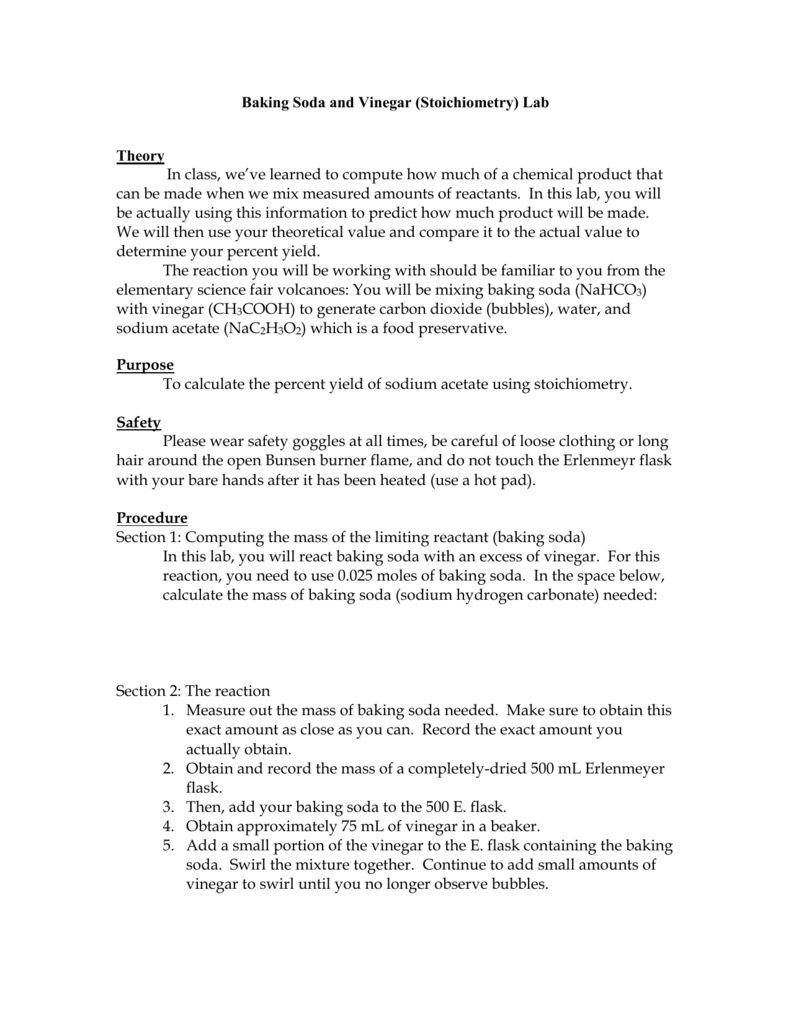
By doing this you will hopefully ensure that you will get 100 actual yield for the reaction. Calculate theoretical mass of NaCl based on a known mass of NaHCO 3.
Baking soda is a powdered chemical compound called sodium bicarbonate and vinegar includes acetic acid.
Baking soda stoichiometry lab. This lab demonstrates the reactivity of two household cooking items baking soda and vinegar. Baking soda is a powdered chemical compound called sodium bicarbonate and vinegar includes acetic acid. These 2 components react in solution to form carbon dioxide water and sodium acetate as shown in the chemical reaction below.
Stoichiometry and Baking Soda NaHCO 3 Purposes. Calculate theoretical mass of NaCl based on a known mass of NaHCO 3. Experimentally determine the actual mass of NaCl produced.
Calculate the percent yield for your experiment. NaHCO 3 s HClaq NaCls CO 2 g H 2 Ol. This lab demonstrates the reactivity of two household cooking items baking soda and vinegar.
Baking soda is a powdered chemical compound called sodium bicarbonate and vinegar includes acetic acid. These 2 components react in solution to form carbon dioxide water and sodium acetate as shown in the chemical reaction below. Baking soda vinegar carbon dioxide water sodium acetate.
Vinegar and Baking Soda Stoichiometry Lab Purpose. To predict the amount of Carbon Dioxide gas that should be produced in a chemical reaction. Then calculate the amount of CO2 released the percent yield.
Baking Soda NaHCO3 Vinegar CH3COOH 2 beakers and electronic balance. Obtain and record the mass of 100 mL beaker. This is beaker A.
Stoichiometry Decomposition of Baking Soda Safety Handle the contents from stove with care to prevent burns. Have you ever baked. Baking soda sodium bicarbonate NaHCO 3 is used in bakery products to ensure that they rise during baking.
As the dough is heated the baking soda decomposes. About Press Copyright Contact us Creators Advertise Developers Terms Privacy Policy Safety How YouTube works Test new features Press Copyright Contact us Creators. Target Stoichiometry Lab Mole Relationships and the Balanced Equation Introduction A simple decomposition reaction of sodium bicarbonate baking soda presents the opportunity for students to test their knowledge of stoichiometry factoring labels and the mole concept.
This outcome-based lab requires the students to pre-. Analysis of Baking Soda Lab Purpose To determine the mass of sodium hydrogen carbonate in a sample of baking soda using stoichiometry Pre-Lab This must be completed in your lab notebook before you will be allowed to begin lab 1. What is the chemical formula for baking soda or sodium hydrogen carbonate.
What ions will form when baking soda is dissolved in water. I explain to them that the baking soda reacts with the acid in the tablet but we will use dilute hydrochloric acid to make sure it all reacts. Slowly students ask more and they start to look at the carbon dioxide.
The plan then becomes to record the mass of the dilute acid solution and tablet before and after the reaction. The after mass should be less because carbon dioxide left the system. Materials List-500-600 mL empty plastic bottle with the bottle cap-Baking Soda 1 package-Distilled White Vinegar 1 bottle of 05-1 L-One or more balloons Must fit over bottle lid-Plastic measuring spoons Prelab.
A The overall equation for the reaction between baking soda and the acetic acid in vinegar experiment is generally written as NaHCO 3 s CH 3 COOH aq CO 2 g H 2 Ol. Baking Soda Stoichiometry Lab In this lab you will combine your powers of observation reasoning equation balancing and knowledge of stoichiometric calculations to earn a perfect 1010 hopefully Procedure - Answer the questions in different colored fonts. Obtain a large Pyrex test tube weigh it on one of the scales in the front of the room.
In this particular lab we used stoichiometry the part of chemistry that studies amounts of substances that are involved in reactions to observe the reactions made by combining sodium hydrogen. Lab Hints Students may ask how much of the baking soda they should use. In keeping with the general practice of not filling a crucible more than half-full there is no correct mass of baking soda to use.
This avoids situations where students believe they must use 200 g of baking soda. In this lab you will need to do a reaction where baking soda will react with an excess of vinegar. By doing this you will hopefully ensure that you will get 100 actual yield for the reaction.
For our reaction we will need to use 005 moles of baking soda which we will. At the same scale place one large scoop of baking soda NaHCO3 into the test tube then using the same scale as before weigh the test tube with the baking soda. Record this mass in the table at right.
You should be able to figure out what mass of baking soda is in the test tube. Vinegar And Baking Soda Stoichiometry Lab. Solved Experiment Gas Stoichiometry And The Gas Laws T.
Gas Stoichiometry Lab Report - When a student is taking a laboratory course they are often asked to write a laboratory report for their course. It is extremely essential to understand how to write a lab report so that the professor has everything they need for grading and they can always refer. There are 3 possible decomposition reactions for sodium bicarbonate baking soda.
Write a balanced chemical equation for each. Write a balanced chemical equation for each. We performed multiple repetitions of the experiment using two fingers of vinegar with varying amounts of baking soda ranging from25 to 400 grams.
Using this technique we discovered that the limiting reactant changed from vinegar to baking soda as the amount of baking soda used increased.
